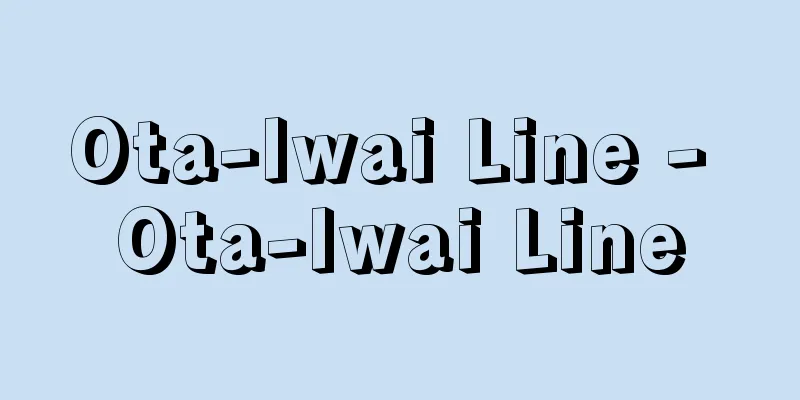Ota-Iwai Line - Ota-Iwai Line

|
...Iwai Iwai (formerly of Kokuro) led Sohyo together with Ota Kaoru (1958-66 chairman of Sohyo, originally from Gokaroren), and they came to be known as the "Ota-Iwai line," and they became representative of the labor movement during the high-growth era. However, the All Japan Seamen's Union and the All Japan Fiber Medal (now Zensen Domei), which criticized Sohyo's political line and changes to its policy on affiliation to international organizations, withdrew from Sohyo, and these organizations later evolved into the Zenro Kaigi (All Japan Trade Union Conference) and Domei (All Japan General Confederation of Labor). From the Labor Movement...The spring offensive was an attempt to organize a nation-wide wage-raising coalition based on unified industrial struggles, unifying the wage demands of each union, aligning the timing of the struggles of participating unions to organize a so-called scheduled struggle in the spring, and using the power of unified industrial strikes to achieve their demands. The emergence of the Ota-Iwai line clearly indicated a change in the line of the Sohyo movement in the sense that it attempted to shift from "all-out struggle" to "unified industrial struggle," but the nature of the movement also had strong continuity with Takano's Sohyo. In fact, Sohyo organized national movements under the banner of "peace and democracy" in opposition to the strengthening of the San Francisco regime, such as the struggle against military bases, the labor union struggle, the struggle against the police law, and even the struggle to prevent the revision of the Security Treaty. ... *Some of the terminology used in reference to the "Ota-Iwai Line" is listed below. Source | Heibonsha World Encyclopedia 2nd Edition | Information |
|
…国労出身)は太田薫(1958‐66総評議長。合化労連出身)とともに総評を指導,〈太田・岩井ライン〉と呼ばれて高度成長時代の労働運動を代表するものとなった。ところで,こうした総評の政治路線や国際組織加盟方針の変更を批判する全日本海員組合や全繊同盟(現,ゼンセン同盟)などは総評を脱退し,これらが母体となって後の全労会議(全日本労働組合会議),同盟(全日本労働総同盟)へと展開していった。… 【労働運動】より…春闘は,産業別統一闘争をふまえてナショナル・ワイドの賃上げ共闘を組織しようとするもので,単産ごとに賃上げ要求額の統一を図り,参加単産の闘争時期をそろえて春季にいわゆるスケジュール闘争を組み,産業別統一ストの力でもって要求の貫徹を図ろうとするものであった。 太田・岩井ラインの登場は,〈ぐるみ闘争〉から〈産業別統一闘争〉への転換を図ったという意味では,明らかに総評運動の路線転換を示すものであったが,その運動の性格には高野総評との連続面も強くみられた。実際,総評は,軍事基地反対闘争,勤評闘争,警職法反対闘争,さらには安保改定阻止闘争など,サンフランシスコ体制の強化に抗して〈平和と民主主義〉を旗印とする国民運動を組織していった。… ※「太田・岩井ライン」について言及している用語解説の一部を掲載しています。 出典|株式会社平凡社世界大百科事典 第2版について | 情報 |
Recommend
Crested screamer
A bird of the Anseriformes class, family Pycnonot...
Ket
…Some of these languages form small families (s...
Pen Club - Pen Club
The PEN Club was founded in London in 1921 by Bri...
Showa Denko Co., Ltd.
Founded in 1939 as the core company of the Mori Ko...
Auditor - Kanji
An institution within a corporation that supervis...
Diaper rash
Also known as diaper dermatitis. The area that com...
Geomagnetism - Chikyudenjikigaku (English spelling) geomagnetism
A field of study that studies the nature and cause...
Takako Irie - Takako Irie
A film actress. Her real name was Higashibojo Hid...
Shomyoji Temple
A Shingon Buddhist temple in Kanazawa-cho, Kanazaw...
"Dr. Quatermass" series
…A British film company that has become synonymou...
Picking food - Kuitsumi
...In Shikoku and other areas, there is a custom ...
Indo-Afghan race - Indo-Afghan race
…The Arabian race lives in the arid regions of We...
Ehécatl - Eekatoru
He is also credited with the creation of mankind ...
Bügel (English spelling)
… A trolley pole is used on low-speed trains and ...
Eboshi no Ushi - Eboshi no Ushi
〘 noun 〙 Wearing a cap instead of a formal attire....








![Suleiman [I] - Suleiman](/upload/images/67cbfba18998a.webp)
